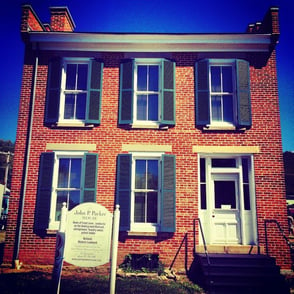 (The National Underground Railroad Freedom Center, The Banks)
(The National Underground Railroad Freedom Center, The Banks)
In February, America and Canada celebrate Black History Month, which promotes knowledge and understanding of the many cultural, scientific, political and artistic contributions that people of African descent have made to our two nations.
Black history is indelibly linked with Cincinnati in many ways. The city, by virtue of its position in a free state just across the Ohio River from Kentucky, was a primary destination for escaping slaves making their way north on the Underground Railroad.
Harriet Beecher Stowe, author of Uncle Tom’s Cabin — the novel that notably stoked the Abolition movement following its publication in 1852 — lived for a time in the Queen City. Tales she heard from her minister father and his abolitionist colleagues (as well as a slave auction she witnessed on a trip to Maysville in 1833) likely inspired the book.
World heavyweight boxing champion Ezzard Charles, basketball star Oscar Robertson and National Baseball Hall of Famers Barry Larkin and Ken Griffey, Jr., have all called the Queen City home.
The city’s large African-American community has produced a number of prominent figures. The Rev. Fred L. Shuttlesworth was a prominent leader of the Civil Rights movement and marched with Dr. King from Selma to Birmingham.
James Brown and Bootsy Collins, among many other musicians at Cincinnati’s King Records, helped to break the cultural color barrier in post-war period and profoundly shaped the course of then-nascent rock ‘n roll.
And world heavyweight boxing champion Ezzard Charles, basketball star Oscar Robertson and National Baseball Hall of Famers Barry Larkin and Ken Griffey, Jr., have all called the Queen City home.
Here in Cincinnati, there are plenty of opportunities for seniors to observe Black History Month by getting out and learning about African-American history and culture. Let’s take a look at just a few of them.
The National Underground Railroad Freedom Center
In 2004, the National Underground Railroad Freedom Center (NURFC) opened downtown in The Banks development. The placement of the museum was symbolic; it faces southward, over the very river that served as the boundary between slave states and free states in the antebellum period.
The museum is a part of Cincinnati Museum Center. It seeks to tell the history of African-American slavery, through the eyes of the people who lived under its cruelty.
Among the exhibits is the only known surviving example of a “slave pen,” which was uncovered in Mason County, Kentucky, moved piece by piece and reconstructed in the museum’s second floor atrium. It’s a tangible and powerful reminder of the legacy of African-American slavery.
The NURFC’s mission extends a bit beyond telling the story of slavery in Americas. It also focuses attention on the history of other oppressed peoples around the world, and on injustices that continue, including human trafficking.
From people living under Fascist regimes of the 1930s and 1940s, to the history of societal oppression in the Eastern Bloc, visitors will find many poignant opportunities for learning about the preciousness of freedom. There’s even a section of the real Berlin Wall on display.
The Harriet Beecher Stowe House
In the Walnut Hills neighborhood, at the corner of Gilbert and Martin Luther King, stands the home where Harriet Beecher Stowe lived during the 1830s, when her father, the Rev. Lyman Beecher, served as the president of the Lane Theological Seminary.
The home is now owned by the Ohio Historical Society and operated by the Friends of the Harriet Beecher Stowe House. It was added to the National Register of Historic Places in 1970.
The home is open to the public Fridays, Saturdays and Sundays from noon to 4 p.m. Guided tours begin on the :15s. Admission is $4 for adults and just $2 for children ages 6-17.
The John Rankin House
Located along the Ohio River in the village of Ripley, about an hour east of Cincinnati on US 52, the John Rankin House is a neat day trip for seniors who want to learn more about Ohio and national history. The home was designated a National Historic Landmark in 1997.
Built in the early 19th Century, it stands on top of a 500-foot bluff overlooking the river. The Rev. Rankin and his family were important “conductors” on the Underground Railroad. The position of the house — with visibility extending dozens of miles — made it perfectly suited as a lookout point and safe place.
Rankin (a Presbyterian minister and friend of William Lloyd Garrison, one of the principal founders of the American Anti-Slavery Society) would keep a watch out for runaway slaves and slave-hunting parties from his perch atop the riverside cliffs.
When the coast was clear, he would hang a lantern on a pole outside his home, to let escapees know they could risk a river crossing. Rankin hand-built a series of limestone steps — the famous “100 Steps to Freedom” — to help runaways climb the bluff up to his home, where he would feed, clothe and shelter them.
Visitors to the home can see the steps, take in the view and imagine what it would have been like for escaping slaves to make their way north in the pitch-black darkness. It’s a powerful experience.
The John P. Parker House
 Also in Ripley stands the home of another famous abolitionist — that of John P. Parker, a former slave who escaped north to become an inventor, industrialist and a conductor on the Underground Railroad. Parker, with his compatriot Rankin and a network of others, helped many slaves escape from the South.
Also in Ripley stands the home of another famous abolitionist — that of John P. Parker, a former slave who escaped north to become an inventor, industrialist and a conductor on the Underground Railroad. Parker, with his compatriot Rankin and a network of others, helped many slaves escape from the South.
After the Civil War, he patented the Parker tobacco press and the harrow — a piece of equipment still in use in some form on virtually every American farm today. In 1890, he built the Phoenix Foundry, following a fire that destroyed his Ripley blacksmith shop. The Phoenix Foundry was, at the time, one of the largest ironworks in the rapidly industrializing Ohio Valley.
Parker lived in his Ripley home from 1853 to his death in 1900. The home was added to the National Register in 1980 and was designated a National Historic Landmark in 1997.
The King Records building
Although it is in disrepair and not open for tours, it’s worth noting that the King Records studios and press still stand in Cincinnati’s Evanston neighborhood, just northeast of downtown, at 1540 Brewster Avenue.
Founded in 1943 by white Cincinnati entrepreneur Syd Nathan, the label began as a country and western music supplier, cutting records for “hillbilly” artists made popular by then-500,000-watt 700 WLW’s seminal Midwestern Hayride radio program.
Soon, however, Nathan realized that a hot market existed — among both whites and blacks — for African-American gospel, and rhythm and blues records (then called “race records”).
He founded sister labels to King — Queen, Federal and Bethlehem — which produced race records and gave famous artists including Earl Bostic, Hank Ballard, James Brown and teenaged session bassist Bootsy Collins their “big breaks.” Eventually, the race records proved to be more popular than the country records, and the sister labels were merged with King, which became a recognized hotbed of early rock and roll.
The building has languished for years under the threat of demolition, although there is a growing and vocal movement to save it and turn it into a museum.
The National Rock and Roll Hall of Fame placed an historical marker there in 2008 and the City of Cincinnati designated it a city landmark in 2015. Earlier this year, Cincinnati’s City Council initiated proceedings to take and preserve the property via eminent domain. It’s worth a stop on your Black History Month tour of the Queen City.
There are plenty of opportunities for seniors living in Cincinnati to observe Black History Month.
These are just a few sights to see. You could also research the history of Cincinnati’s African-American community. The Public Library of Cincinnati and Hamilton County, as well as the libraries of the Ohio Historical Society and the University of Cincinnati, have extensive materials to review.
This Black History Month, think about the price of freedom. And take some time to acknowledge the struggle of those Americans who haven’t always enjoyed it.












